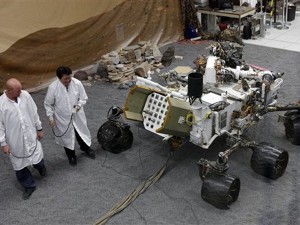
Engineers work on a model of the Mars rover Curiosity at the Spacecraft Assembly Facility at NASA’s Jet Propulsion Laboratory in Pasadena, Calif., Thursday, Aug. 2, 2012. After traveling 8 1/2 months and 352 million miles, Curiosity will attempt a landing on Mars the night of Aug. 5, 2012. AP/Damian Dovarganes
PASADENA, California — After an 8 1/2-month voyage through space, NASA’s souped-up Mars spacecraft zoomed toward the red planet for what the agency hopes will be an epic touchdown.
The fiery punch through the tenuous Martian atmosphere at 13,000 mph (21,000 kph) Sunday night marks the beginning of “seven minutes of terror” as the Curiosity rover aims for a bull’s-eye landing inside a massive crater near the equator.
The latest landing attempt is more nerve-racking than in the past because NASA is testing out a new routine. Curiosity will steer itself part of the way and end on a dramatic note: Dangling by cables until its six wheels touch the ground.
That’s the plan at least.
“Can we do this? Yeah, I think we can do this. I’m confident,” Doug McCuistion, head of the Mars exploration program at NASA headquarters, said Saturday. “We have the A-plus team on this. They’ve done everything possible to ensure success, but that risk still exists.”
Despite humanity’s fascination with Mars, the track record for landing on it is less than stellar. Out of the 14 attempts by space agencies around the world to touch down on Earth’s neighbor, only six have succeeded. NASA has fared better — with only one failure out of seven tries.
In keeping with a decades-old tradition, peanuts will be passed around the mission control room at the NASA Jet Propulsion Laboratory for good luck.
NASA will need it. The $2.5 billion mission comes as the space agency faces a financial crunch. It abandoned a partnership with the European Space Agency to send missions in 2016 and 2018 and, instead, is charting a new future for Mars exploration.
For now, NASA is counting on Curiosity to nail the landing. On the eve of landing day, engineers said the rover looked healthy and on course.
“We’re now right on target to fly through the eye of the needle” at the top of the Martian atmosphere, said mission manager Arthur Amador.
Earlier in the week, a dust storm swirling to the south of the landing site gave the team some pause. Ashwin Vasavada, the mission’s deputy project scientist and Mars weather forecaster, said the storm basically went “poof” and posed no threat.
“Mars appears to be cooperating very nicely with us. We expect good weather for landing Sunday night,” he said.
As Curiosity plummets to the surface, it will rely on the precisely choreographed use of a heat shield and supersonic parachute to slow its descent. Less than a mile from the ground, the hovering spacecraft will unspool cables to lower the rover.
Due to the signal time lag between Mars and Earth (it takes about 14 minutes for a signal on Mars to zip to Earth), Curiosity will execute the landing autonomously, following the half a million lines of computer code designed by Earthlings.
Touchdown was set for 10:31 p.m. PDT (0330 GMT). NASA warned that spotty communication during landing could delay confirmation for several hours or even days.
If successful, Curiosity will join another roving spacecraft, Opportunity, which has been exploring Mars since 2004.
The most high-tech Mars spacecraft ever built, the nuclear-powered Curiosity is equipped with more than a dozen cameras, a weather station and tools to drill, taste and sniff the environment in search of the chemical building blocks of life.
Its target is Gale Crater near the equator, which scientists think is a place where water once flowed — a good starting point to learn whether microbes could exist there. Rising from the floor of Gale is an impressive mountain where mineral signatures of water have been spied at the base.
Life as we know it requires three ingredients: Water, energy and carbon. The missing piece so far is finding carbon. One of Curiosity’s main tasks is to drive to the mountain, chisel rocks and dig into soil in search of the elusive element.
During its cruise to Mars, Curiosity turned on its radiation sensor and sent back data, which should help scientists better understand the risks that astronauts would face on a manned mission.
Before Curiosity can further explore, it must first stick the landing.
Weighing nearly 2,000 pounds (900 kilograms), it is much heavier than Opportunity and can’t bounce to a stop swaddled in air bags; it would break apart if it did. So engineers devised a new trick. Sunday will be the first time that the novel landing routine will make its debut.
Engineer Steve Sell said his eyes will be glued to his computer screen on landing day.
“I just have to keep reminding myself to keep breathing,” Sell said.